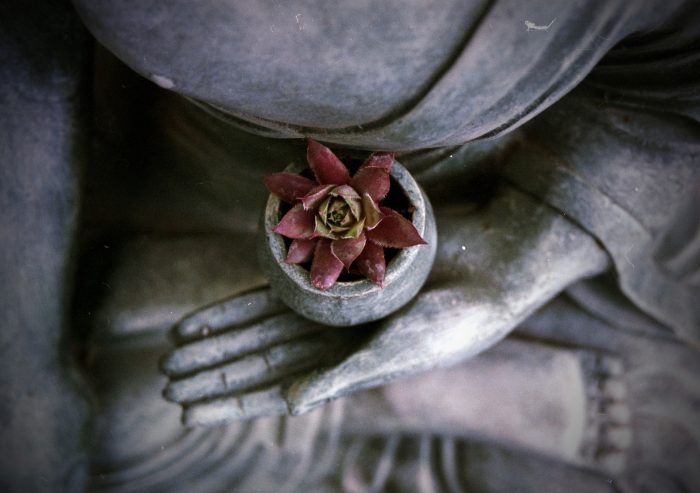We are born into life with death on the horizon.
Sometimes it arrives quickly, sometimes painstakingly, but we can know with certainty that our death will meet us in the end.
With alarms about the novel coronavirus sounding worldwide, it is hard to avoid thinking about it. Rather than shying away every time it comes near, why not take this opportunity to familiarize ourselves with death?
Just as with life, our understanding of death shifts over time.
Touch in with death every now and then. Start wherever you are, whether you are working on the front lines and witness death every day, or whether you are comfortably situated, but want to make progress in your relationship to death.
Of course, trauma may be attached to your personal experience of death, and there is no shame in wanting to seek out help before you navigate the waters on your own.
The following ideas are born out of my own experience, and are meant simply to paint a picture of how we might ease into the process.
My early experience of death was limited to a few family members and pets, yet my childhood games sometimes bordered on the weird. Imagining my own death, I would gather and arrange my favorite objects and lie down in pretend paralysis with my hands folded over my heart. As I grew older and less eager to play out my own funeral, my curiosity turned outward.
I had my first visceral contact with a body after death, when a psychology professor let me handle a human brain. I visited my first cadaver lab during a yoga teacher training, where I felt more awe than revulsion at the many parts that make up the human whole.
My grandfather’s dying was a gradual slide into silence marked by peaks of heartbreak, as the rules of living changed again and again for him. The ice cold feel of his hand in death was a jolt to my system—a reminder that life is brief and precious.
But how easy is it for us to forget the inevitability of death?
Without gentle, consistent reminders, and the will to take those reminders to heart, it becomes too predictable, a cliché couched in fear of the unknown. It shows up in headlines, attached to murder, illness, and unhappy accidents, or in obituaries, where death looks backward in review of life. It dominates the world of cinema and television, a grim punchline or plot point for the protagonist who rarely dies onscreen.
It takes us by surprise when we ourselves witness a sudden death, or go through a near-death experience.
Now, as an adult, I choose to welcome in the mystery of death by taking a walk in my local cemetery, sometimes reading aloud the names I encounter on tombstones and imagining their life stories. For an even softer approach, I look to one of my favorite fantasy novel series, Philip Pullman’s His Dark Materials, in which one character enters a realm where everyone’s death is made manifest as a lifelong companion. Not a sibling, not a lover or spouse, but simply an extra being whose final act is to ease the passage from life into the beyond.
How would it feel if we viewed death as a friend who is there with us, every step of the way?
Even with death, we can practice steadying the mind and radiating compassion—as I discovered again and again while sitting vigil for newly deceased meditators in my community. It is possible to peek through fear and find awe in the presence of the dead. It is also possible to become familiar with death by spending time with those who are dying, through hospice volunteering or other means of community service. I learned that training for hospice work creates a bond between those of us who want to transform their relationship to death, and it helps to demystify the dying process.
For a more esoteric view, I turn to the Tibetan Buddhist teachings on the bardo—the liminal space before and after the moment of death, when the senses shut down, and the elements of the body fade away. In this space, anger can be revealed as hellish experiences, while desire can manifest as insatiable beings who never get what they want. All the thoughts and emotions we cultivate in our mind-stream over the course of life come to the forefront when there is no longer a body to tether us—which can be a scary experience or a blissful one.
It boils down to our lived relationship with being—through shared and solitary suffering and rejoicing.
How can we reduce suffering for ourselves and for others, where our own death is concerned?
You can bring order to it by writing a will and sharing an advance directive for how to dispose of your body. You may be surprised to find out how detailed the questions are, and if you are anything like me, it may take a while to land on the answers.
In the course of my research, I was intrigued to learn about green burials as an alternative to embalming and cremation, which tend to be more expensive or environmentally taxing. To feel the cool embrace of the earth, and the warmth of her many soil-bound subjects as they take sustenance from me, seems a natural way to give up my body.
If I am lucky, I will have a death doula to facilitate my final journey, but at the very least, I can begin to imagine how I would like my life, and death, to be honored.
I can start that conversation with a friend, a partner, or a family member, and see where it takes me.
In the words of Albus Dumbledore from the “Harry Potter” universe,
“To the well-organized mind, death is but the next great adventure.”
Death is always ready to lead us into an unknown expanse, where priorities shift and deception is laid bare. By opening our minds in life to accept the presence of death, we can let go of unnecessary fear, and set ourselves up for a peaceful exit—even in the midst of uncertainty.
“Death is not the opposite of life, but a part of it.” ~ Haruki Murakami
~


 Share on bsky
Share on bsky





Read 2 comments and reply